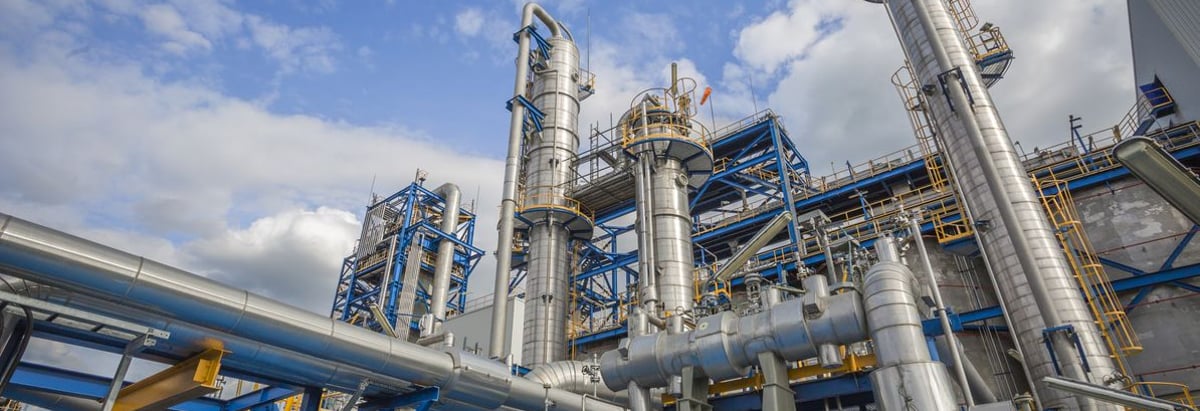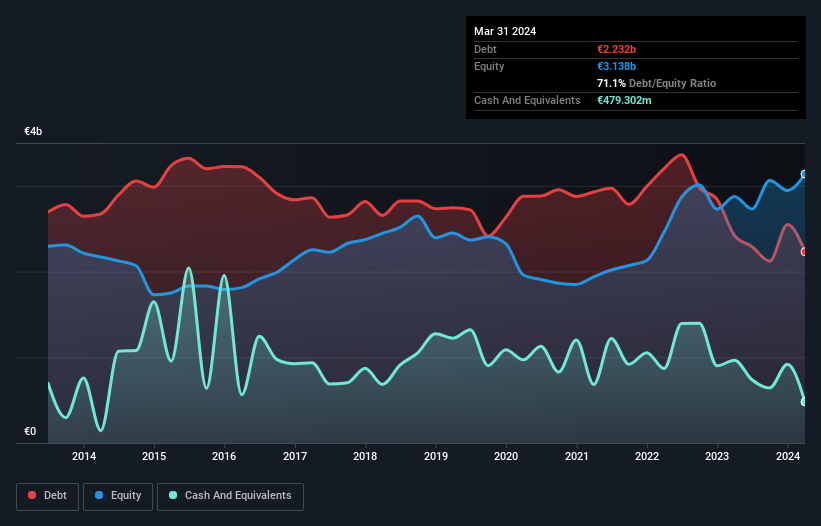- Greece
- /
- Oil and Gas
- /
- ATSE:ELPE
Here's Why HELLENiQ ENERGY Holdings (ATH:ELPE) Has A Meaningful Debt Burden

Warren Buffett famously said, 'Volatility is far from synonymous with risk.' So it might be obvious that you need to consider debt, when you think about how risky any given stock is, because too much debt can sink a company. We note that HELLENiQ ENERGY Holdings S.A. (ATH:ELPE) does have debt on its balance sheet. But is this debt a concern to shareholders?
What Risk Does Debt Bring?
Generally speaking, debt only becomes a real problem when a company can't easily pay it off, either by raising capital or with its own cash flow. Part and parcel of capitalism is the process of 'creative destruction' where failed businesses are mercilessly liquidated by their bankers. While that is not too common, we often do see indebted companies permanently diluting shareholders because lenders force them to raise capital at a distressed price. Of course, debt can be an important tool in businesses, particularly capital heavy businesses. When we think about a company's use of debt, we first look at cash and debt together.
See our latest analysis for HELLENiQ ENERGY Holdings
How Much Debt Does HELLENiQ ENERGY Holdings Carry?
As you can see below, HELLENiQ ENERGY Holdings had €2.23b of debt at March 2024, down from €2.42b a year prior. However, it does have €479.3m in cash offsetting this, leading to net debt of about €1.75b.

How Strong Is HELLENiQ ENERGY Holdings' Balance Sheet?
Zooming in on the latest balance sheet data, we can see that HELLENiQ ENERGY Holdings had liabilities of €3.09b due within 12 months and liabilities of €1.76b due beyond that. Offsetting this, it had €479.3m in cash and €924.0m in receivables that were due within 12 months. So its liabilities outweigh the sum of its cash and (near-term) receivables by €3.45b.
When you consider that this deficiency exceeds the company's €2.45b market capitalization, you might well be inclined to review the balance sheet intently. In the scenario where the company had to clean up its balance sheet quickly, it seems likely shareholders would suffer extensive dilution.
We measure a company's debt load relative to its earnings power by looking at its net debt divided by its earnings before interest, tax, depreciation, and amortization (EBITDA) and by calculating how easily its earnings before interest and tax (EBIT) cover its interest expense (interest cover). Thus we consider debt relative to earnings both with and without depreciation and amortization expenses.
With a debt to EBITDA ratio of 1.6, HELLENiQ ENERGY Holdings uses debt artfully but responsibly. And the fact that its trailing twelve months of EBIT was 7.4 times its interest expenses harmonizes with that theme. The modesty of its debt load may become crucial for HELLENiQ ENERGY Holdings if management cannot prevent a repeat of the 28% cut to EBIT over the last year. When it comes to paying off debt, falling earnings are no more useful than sugary sodas are for your health. The balance sheet is clearly the area to focus on when you are analysing debt. But ultimately the future profitability of the business will decide if HELLENiQ ENERGY Holdings can strengthen its balance sheet over time. So if you're focused on the future you can check out this free report showing analyst profit forecasts.
Finally, while the tax-man may adore accounting profits, lenders only accept cold hard cash. So we clearly need to look at whether that EBIT is leading to corresponding free cash flow. In the last three years, HELLENiQ ENERGY Holdings's free cash flow amounted to 47% of its EBIT, less than we'd expect. That's not great, when it comes to paying down debt.
Our View
To be frank both HELLENiQ ENERGY Holdings's level of total liabilities and its track record of (not) growing its EBIT make us rather uncomfortable with its debt levels. But on the bright side, its interest cover is a good sign, and makes us more optimistic. We're quite clear that we consider HELLENiQ ENERGY Holdings to be really rather risky, as a result of its balance sheet health. For this reason we're pretty cautious about the stock, and we think shareholders should keep a close eye on its liquidity. The balance sheet is clearly the area to focus on when you are analysing debt. However, not all investment risk resides within the balance sheet - far from it. For example, we've discovered 3 warning signs for HELLENiQ ENERGY Holdings (2 are concerning!) that you should be aware of before investing here.
If you're interested in investing in businesses that can grow profits without the burden of debt, then check out this free list of growing businesses that have net cash on the balance sheet.
If you're looking to trade HELLENiQ ENERGY Holdings, open an account with the lowest-cost platform trusted by professionals, Interactive Brokers.
With clients in over 200 countries and territories, and access to 160 markets, IBKR lets you trade stocks, options, futures, forex, bonds and funds from a single integrated account.
Enjoy no hidden fees, no account minimums, and FX conversion rates as low as 0.03%, far better than what most brokers offer.
Sponsored ContentValuation is complex, but we're here to simplify it.
Discover if HELLENiQ ENERGY Holdings might be undervalued or overvalued with our detailed analysis, featuring fair value estimates, potential risks, dividends, insider trades, and its financial condition.
Access Free AnalysisHave feedback on this article? Concerned about the content? Get in touch with us directly. Alternatively, email editorial-team (at) simplywallst.com.
This article by Simply Wall St is general in nature. We provide commentary based on historical data and analyst forecasts only using an unbiased methodology and our articles are not intended to be financial advice. It does not constitute a recommendation to buy or sell any stock, and does not take account of your objectives, or your financial situation. We aim to bring you long-term focused analysis driven by fundamental data. Note that our analysis may not factor in the latest price-sensitive company announcements or qualitative material. Simply Wall St has no position in any stocks mentioned.
Have feedback on this article? Concerned about the content? Get in touch with us directly. Alternatively, email editorial-team@simplywallst.com
About ATSE:ELPE
HELLENiQ ENERGY Holdings
Operates in the energy sector in Greece, the Southeastern Europe, and the East Mediterranean.
Fair value with moderate growth potential.
Market Insights
Community Narratives




